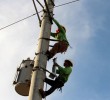Citing that Mindanao mainly depends on the Agus-Pulangi hydro complex, which accounts for half of the island’s power supply, Llaneza said the most that the government can do is “minimize” power interruptions.
By MARILOU AGUIRRE-TUBURAN
Davao Today
DAVAO CITY, Philippines — No power interruptions come May 13 elections? A high-ranking officer of the Department of Energy (DOE) doesn’t think so.
Director Manny Llaneza, Mindanao Field Officer of the DOE, told davaotoday.com Thursday that while the government, the National Power Corporation (NPC) in particular, has contingency plans and is doing its best to prevent the eventuality, he cannot fully assure the people of Mindanao that there would be no brownouts.
Citing that Mindanao mainly depends on the Agus-Pulangi hydro complex, which accounts for half of the island’s power supply, the most that the government can do is “minimize” power interruptions.
Llaneza shared that the NPC already reduced the flow of water in Iligan City’s Maria Cristina Falls so that during the Election Day, more water will be released, which he wished “will be enough na hindi tayo magkakaroon ng problema (to prevent problems).”
Based on the NPC’s current water dispatch protocol, the water inflow has been set around 80-85 cubic meters per second.
Earlier, Mindanao Development Authority (MinDA) Secretary Luwalhati Antonino said the hydro complex generates lower capacity “because of its reduced water intake due to low water levels,” especially during the summer season.
Llaneza maintained that the island remains in a situation where power generation “is wanting,” adding that power cuts will definitely continue until “big ticket” projects come online in 2015, citing the coal-fired power plants (CFPPs) in Toril, Davao City and in Maasin town, Sarangani Province — projects which have been widely opposed by environmental advocates.
He said though that the cities of Davao, Cotabato and Cagayan de Oro are lucky for having their own generators to continue enjoying power services.
For the meantime, he said, modular generator sets are the fastest, albeit temporary, solution to the island’s power woes. “They could buy it on their own, rent it or have the government help them in financing,” he said.
A month’s rent of a modular generator set, which had to be imported from foreign suppliers, costs about PHP 1.4 Million. Llaneza confirmed that this solution would definitely cost more to the power consumers, a point that was raised by a movement of women, the Kidapawan City-Local Council of Women (KC-LCW).
The KC-LCW earlier pointed out that modular generator sets are only “palliative” and “an added burden to the consumers” as it will increase power rates that could trigger a domino effect on the prices of basic goods and services.
Llaneza said that long-term solutions must be done, hoping for more projects like the CFPPs which, according to him, is “very much cheaper” compared to solar power, which are only done in off-grid areas where power cooperatives don’t have a plan yet of electrifying.
In a separate interview, Nilo Geroche, chief of DOE’s Science Research Specialist, Energy Industry Management Division, said that the Energy Regulatory Commission’s approved fit in tariffs is: PHP 9.68 per Kilowatt hour for solar; PHP 8.53 for wind; PHP 6.65 for biomass; and PHP 5.9 for hydro.
Llaneza said that solar power will be used “sometime in the future” as the prices of solar panels have been dropping down with mass production and development of technology.
Quick solution
Large parts of Mindanao have experienced power cuts since last year. It worsened last month affecting mainly General Santos, Iligan, Agusan, Surigao and Zamboanga cities. Kidapawan City in Cotabato province has been experiencing six to eight hours of daily rotational brownouts affecting households, business and industries.
MinDA has planned to conduct cloud seeding operations over Lake Lanao to cause rains and thereby increased water inflow for the hydro complex.
The lake which spans Marawi City and Lanao del Sur is the main source of water for Agus I to II and Agus IV to VII, all of which have a total installed capacity of 727 Megawatts.
Antonino, in a statement Wednesday, said that the move is part of the government’s “quick measures” to bridge Mindanao’s power supply shortfall. With the increased rainfall through cloud seeding, she noted, the elevation of water level could be improved and could allow for water inflow of 100-120 cubic meters per second, the rate needed to increase the capacity of hydro complex to 450-500 MW.
“The 50MW additional capacity to the Mindanao grid resulting from cloud seeding can be expected to reduce brownouts by at least 2 hours,” Antonino said.
Last year, a Mindanao Power Summit was held in Davao City which resulted to various recommendations from the stakeholders, including not to privatize the country’s hydropower plants and power barges.
The Mindanao Business sector through the Philippine Chamber of Commerce and Industry (PCCI) have lamented that business operations across the island have resulted to delayed production/cancellation of transactions (35); percent equipment breakdown (23 percent); revenue losses (20 percent); low output production (12 percent) and partial labor lay-offs (9 percent).
Based on its estimates, the PCCI said that in every hour of power shortage, the agriculture, industry and service sectors lose about PHP 50,000-PHP 200,000 in revenues. (Marilou Aguirre-Tuburan/davaotoday.com)
Agus-Pulangi, Department of Energy, Elections, Mindanao, Mindanao Development Authority, National Power Corporation, Philippine Chamber of Commerce and Industry









